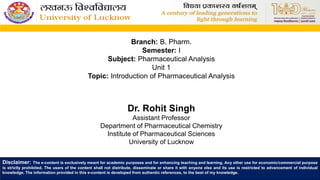
Introduction of Pharmaceutical Analysis.pdf
- 1. Branch: B. Pharm. Semester: I Subject: Pharmaceutical Analysis Unit 1 Topic: Introduction of Pharmaceutical Analysis Dr. Rohit Singh Assistant Professor Department of Pharmaceutical Chemistry Institute of Pharmaceutical Sciences University of Lucknow Disclaimer: The e-content is exclusively meant for academic purposes and for enhancing teaching and learning. Any other use for economic/commercial purpose is strictly prohibited. The users of the content shall not distribute, disseminate or share it with anyone else and its use is restricted to advancement of individual knowledge. The information provided in this e-content is developed from authentic references, to the best of my knowledge.
- 2. Volumetric Analysis • It is a general term for a method in quantitative chemical analysis in which the amount of a substance is determined by the measurement of the volume that the substance occupies. It is commonly used to determine the unknown concentration of a known reactant Volumetric analysis is often referred to as titration, a laboratory technique in which one substance of known concentration and volume is used to react with another substance of unknown concentration.
- 3. Pharmaceutical analysis and its scope • Pharmaceutical analysis - Establish the physical properties, toxicity, metabolites, quality control, etc. • Environmental analysis - Pollutants, soil and water analysis, pesticides. • Forensic analysis - Analysis related to criminology; DNA finger printing, finger print detection; blood analysis. • Industrial quality control - Required by most companies to control product quality. • Bio analytical chemistry and analysis - Detection and/or analysis of biological components (i.e., proteins, DNA, RNA, carbohydrates, metabolites, etc.). This often overlaps many areas. Develop new tools for basic and clinical research.
- 4. Classification of Quantitative Analysis • 1. Chemical Method • 2. Electrical Method • 3. Instrumental Method • 4. Biological & Microbiological Method
- 5. 1. Chemical Method a. Volumetric Method b. Gasometric Method c. Gravimetric Method.
- 7. 3. Instrumental Method Spectroscopic Method Chromatographic Method
- 8. 4. Biological & Microbiological Method Antimicrobial Assay based on Cup plate method
- 9. The methods of expressing concentration are based upon chemical formula or combining power, The word "Concentration“ is frequently used as a general term referring to a quantity of substance in a defined volume of solution. Molarity (M): The molarity of a solution expresses the number of moles (gram- molecular weights) of solute dissolved in 1000 ml (1Litre) of solution. Molality (M): The molality of a solution expresses the number of moles (gram- molecular weights) of solute dissolved in 1000 gm of solvent. Normality(N): The normality of a solution expresses the number of equivalents (gram-equivalent weight) of the solute in one litre of solution.
- 10. Primary standard substances- The reagent which is ready to be weighed and used to prepare a solution with known concentration (standard) Properties of primary standard substances: • It is extremely pure • Highly stable • It is anhydrous • It is less hygroscopic • Has very high molecular weight • Can be weighed easily • Should be ready to use and available • Should be preferably non toxic • Should not be expensive
- 11. Secondary standard: A secondary standard is a standard that is prepared in the laboratory for a specific analysis. It is usually standardized against a primary standard Standardization: The process by which the concentration of a secondary standard substance is determined by titration with a known concentration of primary standard substance Examples for Primary Standard Substances 1. Benzoic acid for standardisation of waterless basic solutions. 2. Potassium bromate (KBrO3), Potassium dichromate ( K2Cr2O7) for standardisation of sodium thiosulfate solutions. 3. Sodium chloride(anhydrous) for standardisation of silver nitrate solution.
- 12. Examples for Secondary Standard Substances 1. Acid Base Titrations: Acid: Hydrochloric acid, sulphuric acid, oxalic acid Base: Sodium hydroxide, potassium hydroxide. 2. Redox Titration: Oxidising agents: Potassium permanganate, Iodine. Reducing agents: Sodium thio sulphate, potassium iodide. 3. Precipitation titration: Silver nitrate, ammonium thio cyanate 4. Complexometric titration: EDTA
- 13. Errors Definition: Error is the difference between the true result (or accepted true result) and the measured result. Expression of Errors Errors are expressed either in absolute terms or in relative terms Absolute Errors: E abs = Calculated value –True Value
- 14. Types of Errors: 1. Determinate or systematic error 2. Indeterminate or random error Determinate Error. • Determinate errors are caused by faults in the analytical procedure or the instruments used in the analysis. • The name determinate error implies that the cause of this type of error may be found out and then either avoided or corrected. • Determinate errors are systematic errors; that is, they are not random.
- 15. The following are the types of determinate errors may be noted: a) Operational and personal errors b) Instrumental and reagent errors c) Errors of method d) Additive and proportional errors
- 16. Indeterminate Errors • Indeterminate errors are not constant or biased. • They are random in nature. • Are the cause of slight variations in results of replicate samples made by the same analyst under the same conditions.
- 17. References- 1. Beckett A, Stenlake J. Practical pharmaceutical chemistry, CBS publisher & distributors pvt. Ltd, 4th edition part-1. 2. Baghel U.S; Arora P; Kabra R; Singh A. Pharmaceutical Analysis I, Medical Publishers, Edition 2017.